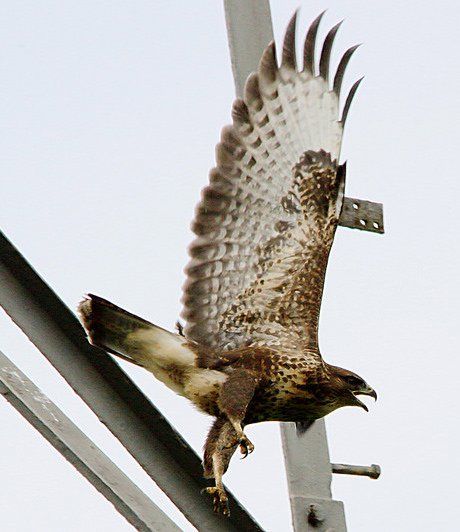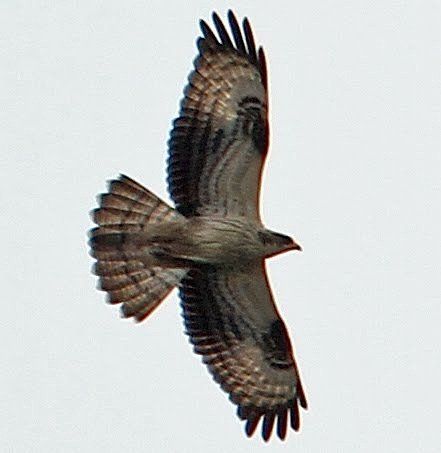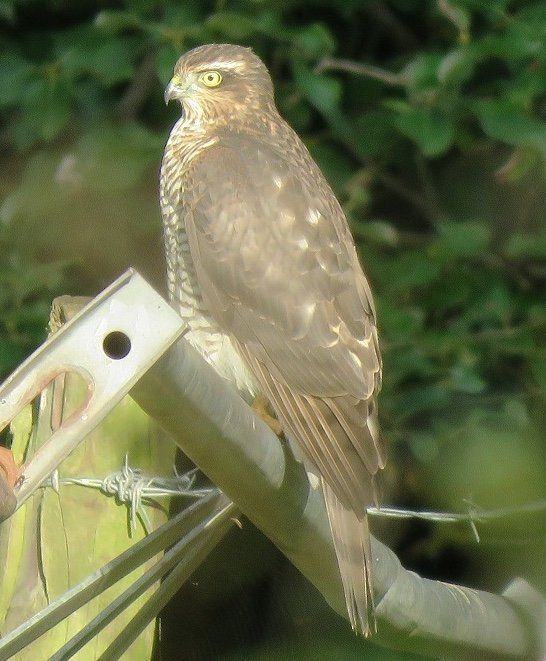ROUGH-LEGGED BUZZARD
Buteo lagopus
Scarce winter visitor
1987
- One was seen near Fewston Reservoir on 18th April.
1994
- Our area benefited from the large influx of this species into Britain in late October. The moorlands held probably three birds, possibly more, and provided some of the best bird-watching this area has seen. Many bird watchers came from outside the are and as a result some locally rare species were reported. All records relate to immatures and indeed this was the trend nationally. The first arrival was at March Ghyll on 23rd October where a bird spent the whole afternoon hunting persistent hovering taking place. The following day two birds gave good views at the same date. A single was recorded here the following day. One of the ‘March Ghyll birds’ was thought to have moved to nearby Timble on 28th October where views down to 20m were obtained by one observer. One was also reported in Wharfedale on the same date. The Timble bird remained in a small open area at Ellercarr all the next day and at least all morning on 30th October. Also on this latter date at nearby Beamsley Moor two birds were observed for over an hour, one being mobbed by a Common Buzzard. Up to two birds were reported around Timble and Round Hill until 6th November. Sightings after this date until the year-end were patchy and involved just single birds. The remaining records were: Timble 11th and 19th November, Kex Gill 13th November, March Ghyll 20th and 21st November and 11th December, and Wharfedale between 16th and 20th December.
1995
- Following the influx in Autumn 1994, single immatures were reported on seven dates in the first three months. It is unclear whether all sightings involved one individual. After being seen in Wharfedale on New Year’s Day there were no reports until 4th and 5th February when one was in the Timble area. The remaining records came from Wharfedale on 12th, 14th and 23rd February and 19th March.
1996
- Rough-legged Buzzard was recorded for the third successive year. A juvenile frequenting the Wharfedale area was seen on 1st December, and again on 8th December.
1998
- The year’s only sighting was of a bird which was well seen flying low over Barden Fell on 5th March. It was believed to be a first-winter bird, taking into consideration the amount of black on the belly and the very pale patches on the upper wings.
2001
- It was a welcome, if brief, return of a species not seen in the recording area since 1998. A juvenile bird provided the sole observer with excellent views on Denton Moor on 15th November.
2008
- The first record since 2001, a bird flew north-east at Trough Lane on 29th March.
2009
- One at Barden on 6th January can now be included, following acceptance by the YNU.
2010
- A bird soaring over Silsden on 7th November was watched for several minutes, before leaving to the west.
2011
- This scarce buzzard was represented for the fourth year in a row by a bird seen on Rombald’s Moor on 15th October.
2012
- Now seen for the fifth successive year, a juvenile was discovered on Morton Moor (not far from the previous year’s bird), and obligingly remained from 1st to at least 15th February.
HONEY BUZZARD
Pernis apivorus
Scarce passage visitor
1991
- A dark-phase bird flew down the valley at Elland Gravel Pits on 8th June, veering off to the north when mobbed by two Lesser Black-backed Gulls.
1993
- An excellent year with two records coinciding with large numbers reported nationally. A single at Stockbridge Reserve on 29th August was followed by another in Wharfedale on 6th September. Good views were obtained and both birds were well described.
1996
- A bird flying west over Cullingworth fields on the morning of 9th July was an excellent find, and provided the fourth record for the Group.
1999
- A juvenile was seen and photographed at Nan Scar above Leeming Reservoir on 22nd September. The bird was being mobbed by Carrion Crows, and perched in a tree briefly before flying off south-westwards over White Moor.
2000
- The unprecedented influx of Honey Buzzards into Britain in September and October was reflectedly locally in the five records submitted for that period. Initially, two birds were seen on Ilkley Moor on 26th September, followed by one over Halifax on 30th. On 1st October one was reported over Denholme Clough, and what was probably the same bird over Thornton Moor Reservoir. A further bird was seen at Beaverdyke Reservoir on 8th October, and the final bird flew south over Kex Gill the following day. In addition, a bird which could have been this species, but not specifically identified, flew north-west over Mount Tabor on 6th October, and a report of a further bird at Thornton Moor Reservoir was not supported by a description.
2008
- A juvenile bird was watched from Barden Scale on 17th September, with further sightings of what may have been the same bird on the following two days, though only the one seen on the 19th could be definitely aged also as juvenile.
2010
- A record of a bird over Thornton Moor Reservoir on 22nd September has been accepted by the YNU Records Committee.
COMMON BUZZARD
Buteo buteo
Very common resident, passage migrant and winter visitor. History of Common Buzzard in Bradford Ornithological area
2015
- Increasingly common resident, passage migrant and winter visitor.
Although the 250 records are slightly down on last year (probably for those reasons mentioned in the Editorial), the species continues to attract attention, and was reported throughout the recording area. In the first three months up to six birds were observed from Denton Moor, Askwith Moor, Barden Scale, Norwood Edge, Slippery Ford and Heights Lane (Bingley). There were also three birds on Shelf Moor in February, further evidence that this species has become established in the south of the area.
On 13th May seven birds, most of them on passage, were seen from Keighley Moor Reservoir and in autumn, an aggregate 47 birds was recorded at the Oxenhope Watchpoint. The largest group of these comprised 13 birds which drifted south-westwards on 16th September.
There were numerous reports of breeding, and breeding-related activity. In the north 11 sites produced up to 20 young, with breeding also proved in Airedale, where a family party of two adults and four young were disturbed whilst they fed on Baildon Golf Course on 12th August. In addition, courtship displays were witnessed on Keighley Moor, and at Rivock Edge and Riddlesden, all in the south, and in Wharfedale and the Washburn, where family parties were also noted.
2016
- In the 30 years the Group has been operating, this raptor has gone from a single record in 1987 to being one which richly justifies the epithet “common”.
With some 300 records, 2016 was in line with other recent years, but represents an increase in real terms, as fewer reports are now received from the known stronghold of Barden. Moreover, every part of the area, including urban and suburban areas, is now represented, and reports are no longer dominated by Wharfedale and the Washburn Valley. Against this background, it is unsurprising that a conservative estimate would indicate at least 230 birds were seen.
The maximum count was nine birds at Whetstone Gate in February, and between six and eight birds were noted from Middleton Moor, the Washburn, and the Barden/Bolton Abbey area. Visible migration watches accounted for totals of 21 birds past Caldene Fields and 22 from Oxenhope Watchpoint, and there were many other reports of birds evidently on passage.
Breeding success was particularly well-reported (thanks largely to the work of the assiduous ringer, PRo), and 18 pairs raised 31 young in the northern sector, with another five pairs in the south indicating potential breeding activity. However, given the probable number of birds in the area, it is still likely that breeding overall is under-recorded.
2017
- Up to 10 birds are now regularly seen in the area, although this figure was attained only once, at Barden Scale, and the bigger counts are generally made in Wharfedale and the Washburn. That said, seven were over Queensbury in March, and on autumn migration at Oxenhope, and increasing, numbers are being seen in the south and west of the recording area.
Breeding successes were in line with last year: 34 young were raised, all but four in the north of the area, though breeding was suspected at a further site in the south.
2018
- An increased number of records confirms the species’ abundance in our area, and there were many counts of between five and ten birds, the latter from Timble Ings, with slightly smaller counts at Marley, Warley Moor Reservoir, March Ghyll Reservoir, Barden and Oxenhope Watchpoint. Twenty-two nests were located from which 33 young were raised, in line with last year.
SPARROWHAWK
Accipiter nisus
Common resident breeder. History of Sparrowhawk in Bradford Ornithological Group area 2009 - 2018.
2014
- There were nearly 200 records, very much in line with previous years, from a wide-range of locations right across the area. This raptor was seen on numerous occasions, soaring over woods, chasing other birds through gardens and flashing through woodland habitats. At Oxenhope, during the autumn migration watch, a seasonal total of 21 birds represents a satisfactory return and is about the same as in 2013. At Barden Scale, on 31st October, five birds, all together at one stage, were thought to be a family party. In Wharfedale five young were ringed at one nest and four more at another, but a third was less fortunate, having been abandoned (PRo).
2015
- Although records are down by 25%, this species remains widespread. This spectacular raptor was seen on numerous occasions, soaring over woods and flashing through gardens and parks. There were no confirmed breeding records this year, but evidence from reports suggests that behaviour at many sites was a strong indicator of this occurring. During autumn migration, seven birds were watched as they traversed the moorland around the Oxenhope watchpoint and six others were similarly recorded in South Bradford at Caldene Fields.
2016
- Though the 130 records represents a drop of 35% in the last two years, the data received indicates the species is well-established in a range of suburban as well as rural environments, and reports from the suburbs now account for 60% of the total. One of the attractions here is, of course, the presence of garden feeders, of which several birds took advantage, successfully predating a Dunnock, Greenfinch and a young woodpecker. A bird at Otley was less successful, as the Blackbird it was pursuing flew down onto the road in front of a following car, successfully avoiding the hawk and the car! Autumn watches at Caldene Fields produced 25 records of 35 birds, though some of these might, of course, have been local residents.
Breeding was fairly evidently under-recorded. There was only one report of display, and the single report of definite success referred to a nest with three young in the Washburn, with just a record of a juvenile near Keighley indicating possible local breeding there.
2017
- Widely reported from across the area, but without comparable breeding information, which consisted of only five reports from Wharfedale, Airedale and the Washburn.
2018
- Once again, well-reported from right across the area, but with fewer breeding records than last year. These came from Marley, Thornton and Lindley Wood.
NORTHERN GOSHAWK
Accipiter gentilis
Scarce resident and passage visitor History of Goshawk in the Bradford Ornithological area 2009 - 2018.
2012 - A bird displaying on 13th April was seen at one of the locations where this has been noted in the past, and there were just three other records of individuals, one of them a female, in the same general area on 6th March, and 23rd and 24th April. A male seen on 18th February, and a female on the 28th, were not far from another location where apparently territorial birds have been located in previous years.
2014 - There were two reports of birds in the north of the area, one on 1st February and the other on 13th March, which was a male seen sitting out on the edge of a plantation. These were the first records since 2012.
2015 - There were two reports of singles, one from the north of the area in March, and one from Paul Clough on 12th October.
2016 - The Group’s 1997 Report referred to it as being “the worst year in a long time for spring display”, notwithstanding nearly 20 observers submitting records of up to 20 birds! Such is the species’ decline locally that this year’s one record is the lowest ever: a female near Otley on 14th February.
2017 - A female seen in the Washburn on 24th November was the only record.
2018 - Just one record, for the second successive year. A male was seen in the Washburn Valley between 3rd and 9th April, during which time it performed perched and flight displays.



